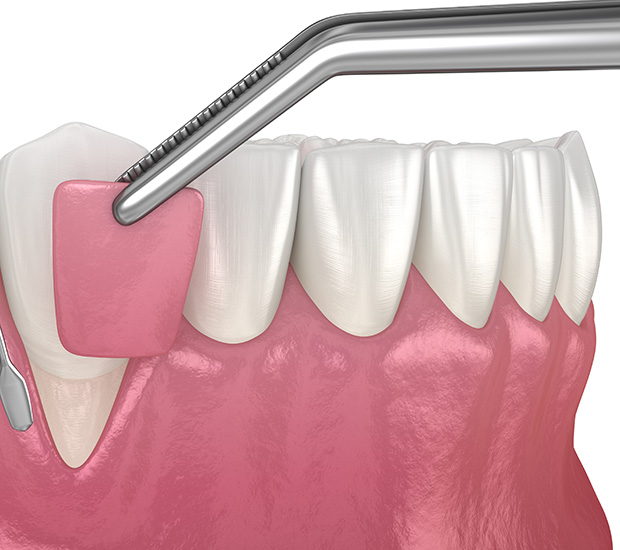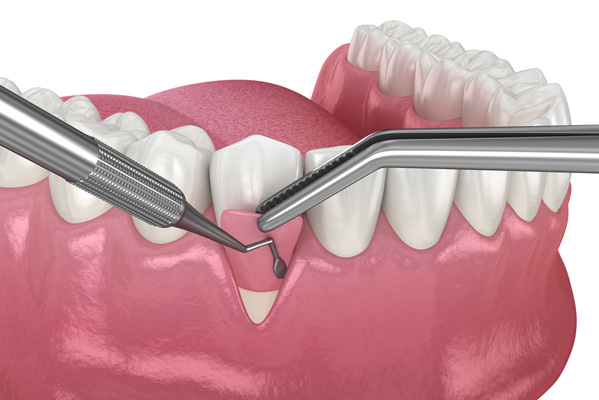Gum GraftingThe Woodlands, TX
Gum recession can negatively impact one's smile and oral health. If left untreated, it may even lead to tooth loss. Gum grafting can help reverse the effects of gum recession by using healthy gum tissue to rebuild the receded gums.
Gum grafting is available at Montgomery County Periodontal Associates in The Woodlands and the surrounding area. When it comes to gum recession, immediate action is necessary. Call us today at 281-404-7548 to schedule an appointment or learn more about our services.
Reasons for Gum Grafting
One cannot understand gum grafting without first understanding gum recession. In gum recession, the tissue surrounding the teeth pulls away to expose the tooth or tooth's root. Since the gum acts as a protective barrier, gum recession may cause damage to the bone supporting the teeth. Unfortunately, gum recession is an oft-overlooked, common issue among American adults that does not get addressed until it has already progressed.
The most obvious sign of gum recession is aesthetic: a noticeably gummier smile. However, gum recession and gum grafting are more than just matters of aesthetics. If left untreated, exposed tooth roots can lead to tooth sensitivity or even tooth loss. Gum grafting is a surgical procedure designed to reverse gum recession and its effects.
Check out what others are saying about our Gum Grafting services on Yelp: Gum Grafting The Woodlands
Types of Gum Grafting
The type of gum grafting performed usually comes down to the patient's unique anatomy and needs. There are three main types of gum grafts: connective tissue grafts, free gingival grafts, and pedicle grafts. Connective tissue grafts and free gingival grafts take tissue from other areas of the mouth, while pedicle grafts use tissue from around the affected area. They then pull the graft tissue down or over the affected area. Patients should note that this type of gum graft is only possible in persons with enough gum tissue in the areas around the receded gums.
Free gingival grafts remove a small portion of tissue from the roof of the mouth, which Dr. Mason then stitches to the targeted area. Free gingival grafts are generally recommended for patients with thin gums who require extra tissue to prevent further gum recession. The most common type of gum graft is a connective tissue graft. This type of graft involves opening a small flap in the roof of the mouth to remove a portion of connective tissue underneath the top layer. Then, Dr. Mason stitches the tissue graft next to the targeted area to cover the receded gums.
Recovering from Gum Grafting
Since gum grafting is an outpatient procedure, patients will be able to leave the office once the surgery has been completed. Depending on their situation, patients may need to wait an hour or two before leaving. This allows our team to observe the patient for any signs of complications. Complications of gum grafting are rare, and they are minimal even when they do occur. They may include bleeding, swelling, teeth feeling looser, teeth sensitivity, spaces appearing between the teeth, and infection. Most patients can return to work the next day, and any pain they experience lasts only a few days and is manageable with over-the-counter medications. However, the amount of pain and discomfort they undergo varies depending on the procedure and the patient's tolerance level.
The mouth typically takes only a week or two to heal fully, though it may take longer. Most patients require a follow-up appointment to ensure the healing process is proceeding properly. Dr. Mason may also remove any stitches as necessary during these appointments. Gums may look different and feel a little tighter and firmer after surgery. Potential signs of infection include (1) fever and pus, (2) persistent bleeding, even after applying pressure, and (3) unexpected bruising, pain, and swelling. Patients experiencing any of the above symptoms should call our office immediately.
Call Us Today
Gum grafting can reverse the aesthetic effects and stop the negative health effects of gum recession. We at Montgomery County Periodontal Associates may be able to help. Call us today at 281-404-7548 to schedule an appointment or learn more about our services.
Frequently Asked Questions
Does dental insurance cover gum grafting?
The answer to this varies on a case-by-case basis. However, many people are able to get all or part of their gum grafting surgery paid for by their provider. Call your insurer directly to get the best understanding of what to expect.
Are there any risk factors for gum recession?
Gum disease is the leading cause of gum recession. Other risk factors include certain medications, old age, genetic predisposition, high levels of stress, tobacco use, and a habit of clenching or grinding the teeth. Patients with obesity or other systemic diseases may also be at heightened risk.
Can I be under anesthesia for my gum grafting surgery?
You can be under general anesthesia for all three types of gum grafts. General anesthesia leaves patients unconscious during the procedure. If you are interested in sedation dentistry, make sure to bring this up with Dr. Mason well in advance of the procedure to allow us to determine the best course of action.
How long will the effects of gum grafting last?
While gum grafting effectively repairs the damage of gum recession, it is not a guarantee against further gum damage in the future. Patients must remain vigilant in maintaining regular dental checkups and maintaining good oral hygiene even after the procedure. With proper care, however, the effects of gum grafting can last a lifetime.
What are the signs of gum recession?
It is not uncommon for patients to not realize their gums are receding until the condition has already progressed. As mentioned earlier, the first change they notice is usually aesthetic: a noticeably gummier smile with a longer-looking tooth and increased space between the teeth. Some patients may also fear losing teeth as a result, and it is not uncommon to experience sensitivity to heat and cold due to the newly exposed tooth roots.
What are the gums, and why are they important?
Also known as the gingivae, the gums are the pink tissue in the mouth attached to the teeth. Each set of teeth has its own set of gingivae, which is heavy and well-supplied with blood vessels beneath its mucous membrane. When intact and attached to the jawbone, the gums cover and protect the tooth roots.
Contact Us
Montgomery County Periodontal Associates is located at 1001 Medical Plaza Dr Ste 110 The Woodlands, TX 77380.





